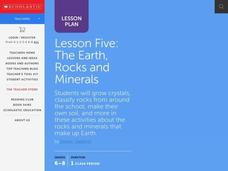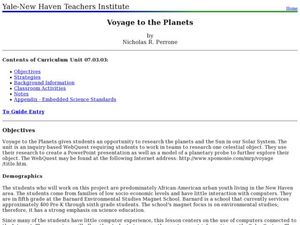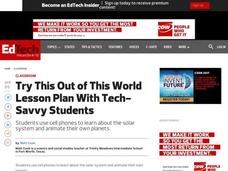Curated OER
Outer Space Circus
Young scholars investigate the concept of other planets and conduct research using a variety of resources. They focus upon a planet and its gravitation, surface, and atmospheric conditions. The lesson plan contains specific steps for the...
Curated OER
Wish You Were Here
Learners work in small groups to research information about planets in the solar system. They create picture postcards from space, drawing images they imagine they would see while traveling to a planet. They then write personal messages...
Curated OER
Metallic Galactic Mobile
Students create 3-dimensional models of their own imaginary galaxies of newly discovered planets. They write fictional accounts of their experiences visiting each new planet. Students writing includes a recognizable beginning, middle,...
Scholastic
Lions, Tigers, and Slugs? Oh, My!
Explore the power of words with your class by analyzing the connotations of fictitious sports team names. Learners discuss team names and the mental images they convey. They create logos to illustrate the meanings and...
Scholastic
Lesson Five: The Earth, Rocks and Minerals
Apply the principles of geology to a series of collaborative, hands-on class activities. Young earth scientists learn more about igneous, metamorphic, and sedentary rocks before classifying and weathering rocks that they find....
Curated OER
Planet Research and Brochure
Fourth graders design a brochure based on the planet that they researched. In this planets lesson plan, 4th graders include the data, important facts, and completed as a team.
Curated OER
Voyage to the Planets
Students examine the planets in the solar system. For this planetatry lesson students complete a project using a WebQuest program.
Curated OER
Travel Brochure
Use the Internet to find facts about the planets. Cooperative groups design a travel brochure for a planet. They use a desktop publishing program to create the travel brochure.
Science 4 Inquiry
A Whole New World: The Search for Water
Scholars find Earth won't support humans much longer and need to identify a planet with water to inhabit. They test four unknown samples and determine which is the closest to water. Then they explain and defend their results.
Science Matters
Thermal Energy Flow in Materials
The sun sends the earth 35,000 times the amount of energy required by all of us on the entire planet, every day. The fourth lesson in the 10-part series looks at how light energy from the sun transfers into thermal energy. Scholars build...
Curated OER
Bring Your Lessons to Life with Videos
Take advantage of pupils' fascination with exciting, visual presentations by using movie clips to demonstrate key concepts.
Center for Math and Science Education
Solar System Launch
Trying to understand the vastness of outer space can be quite a challenge for young scientists. Help put things in perspective with this cross-curricular activity as students work in pairs creating scaled models of...
California Academy of Science
Sustainable Food Solutions: Weighing the Pros and Cons
A growing demand for sustainable food systems comes from schools and even some cities. So what are some solutions? Scholars consider four different ways to approach sustainable food solutions and list the pros and cons of each. The fifth...
Curated OER
What Is Clay?
This resource could come in handy the next time you feel like teaching about clay. Basic sculpting techniques, vocabulary, and history of clay are outlined in this informative resource. Use prior to teaching an art project involving...
Curated OER
Bacteria Lab II: Effect of Bacteriocides
Written to follow "Bacteria Lab I: Preparing Agar Plates and Culturing Bacteria," also found via the Lesson Planet site, this lab sheet instructs your microbiologists to test a bacteriocide for effectiveness. In the preceding lab, they...
Curated OER
Group 15, The Nitrogen Group
This short presentation provides a convenient introduction to the nitrogen group in the periodic table of elements. A graphic displays where they are placed in the periodic table. The nitrogen cycle is mentioned and ammonia is explained....
Curated OER
Soccer - Skeleton Outline
This worksheet goes directly along with a PowerPoint presentation called - Soccer Notes. You can find it on our Lesson Planet website. The class can take notes on the worksheet as the teacher shows the PowerPoint and talks about the...
McGraw Hill
Gravity Variations Interactive
What would a baseball game look like on the moon? Probably a lot of home runs! A creative activity explores the motion of a projectile on the surface of different bodies in the solar system. Participants adjust the angle and...
Curated OER
Out of This World
Fifth graders animate their own planets. In this solar system lesson, 5th graders use smartphones and the software, GoKnow Sketchy, to create images for presentations on their created planets that appear to be animated when played...
Curated OER
Where in Our Solar System Are We?
Second graders research distance between planets and the sun using encyclopedias. They use toilet paper sheets as a unit of measurement (50 million km.) students stand at planet locations using toilet paper to measure distance between.
Curated OER
KNOW YOUR PLACE IN SPACE
Learners examine the positions of the nine planets in respect to our solar system and explain the unique characteristics of each planet.
Curated OER
Earth Science
Students explore the planets and celestial bodies in our solar system. In this outer space lesson, students identify the planets and record journal information about them and other celestial bodies. Students define outer space words.
Curated OER
Online Planetary Tour
Students develop an interactive presentation about the planets for their fictional interplanetary travel agency. They demonstrate their knowledge of internet research techniques and the Solar System through their interactive planetary...
Curated OER
Bringing the Solar System to Life
Students walk marked paths as they simulate the orbit of the planets. In this solar system lesson, students recognize the relationship between the sun and the planets. Students visualize how the phases of the moon are seen.

























